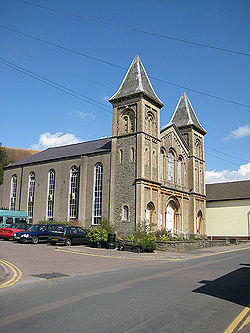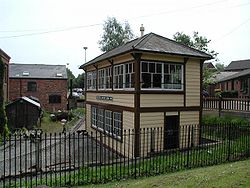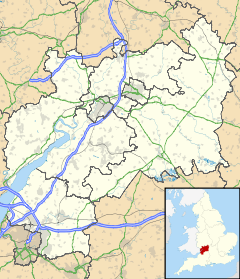- Coleford, Gloucestershire
-
Coordinates: 51°47′28″N 2°36′58″W / 51.7910°N 2.6162°W
Coleford 
Coleford Baptist Church
Coleford Railway Museum
 Coleford shown within Gloucestershire
Coleford shown within GloucestershirePopulation 8,351 OS grid reference SO5710 District Forest of Dean Shire county Gloucestershire Region South West Country England Sovereign state United Kingdom Post town COLEFORD Postcode district GL16 Dialling code 01594 Police Gloucestershire Fire Gloucestershire Ambulance Great Western EU Parliament South West England UK Parliament Forest of Dean List of places: UK • England • Gloucestershire Coleford is a small market town in Gloucestershire, England in the west of the Forest of Dean with a population of 8,351 (2001 census). It is situated some four miles east of the Welsh border, and is close to the Wye Valley, a popular walking and canoeing area. It is the administrative centre of the Forest of Dean district.
History
Coleford takes its name from one of two brooks that merge in its centre and was, as its name suggests, a fording point. The streams were culverted in the 19th century[citation needed], but the one flowing through St John's Street was reopened in 2001 to allow for maintenance work, before being recovered.
Coleford is one of the oldest Forest of Dean towns, largely developed before, and not deeply affected by, coal mining, which became the Forest's staple industry during the 19th and early part of the 20th centuries. For this reason it differs visually from Cinderford, the other major Forest town. Coleford's architecture is mainly Georgian in appearance[citation needed], although many of the façades cover much older structures.
In 1798, work commenced on Whitecliff Ironworks, situated on the south-western edge of Coleford.[1] Despite being managed by the noted Scottish metallurgist, David Mushet, the works were not successful and ceased production by 1816.[2] Other notable buildings include The Angel public house, with its large arched entrance, hinting at coaching inn days; what was Trotters Department Store, now home to Fairways Furnishings; and the clock tower in the town centre. This tower was originally attached to an octagonal church, built in 1821; but when, in 1882, the edifice was considered too small for the town's population[citation needed], the main building was demolished. A much larger ecclesiastical building (St John's) was built on a hillside overlooking the town. A market hall stood next to the clock tower until the 1960s.
Today
Coleford was more able to adapt to the mine closures of the 1950s than its neighbour Cinderford. Today, due to its prime location in the heart of the Forest, it is popular with walkers and cyclists, and the local council has been striving to encourage further tourist interest. There is a large factory here, originally called Carters, then Beechams, and now part of GlaxoSmithKline, the sole production facility for Ribena and Lucozade. One old building that has survived is the former goods shed for the defunct railway line to Monmouth; it is now the Coleford GWR Museum.
The town is home to author Andrew Taylor, and children's writer and illustrator Shoo Rayner. The poet Paul Groves lived locally from 1971 to 1996. Mary Howitt, author of over 200 books, was born here on 12 March 1799.[3]
References
Categories:- Forest of Dean
- Market towns in Gloucestershire
- Towns in Gloucestershire
Wikimedia Foundation. 2010.








